Did the Reconstruction Era following the Civil War result in freedom, equality and civil rights for African Americans?
The Reconstruction Era lasted from the end of the Civil War in 1865 to 1877. Its main focus was on bringing the southern states back into full political participation in the Union, guaranteeing rights to former slaves and defining new relationships between African Americans and whites. While very little fighting occurred on Iowa soil and Iowa had never legalized slavery, black migration of former slaves into the region and the national focus on civil rights forced Iowa to reconsider its own racial relations.
Amending the U.S. Constitution during Reconstruction
When southern states seceded from the Union, they withdrew their representatives from Congress, leaving both the Senate and the House under the control of the North. While most white Americans still held views that whites were superior to African Americans and were not yet ready to integrate society, many were sympathetic to the plight of freed slaves and wanted to promote their welfare. On the political front, Republicans were eager to give African Americans the right to vote because they anticipated that African Americans would strongly support them at the polls.
To achieve these goals, Republicans needed to amend the U.S. Constitution, a process that requires approval of two-thirds of each chamber of Congress and ratification by three-fourths of the states. Republicans felt an urgency to get these measures approved before southern congressmen returned to Washington, D.C., who could block the process. In 1865, Congress passed and states approved the 13th Amendment to the Constitution prohibiting slavery. In 1868, the 14th Amendment was ratified granting "equal protection of the law" and "due process" to all citizens to prevent southern states from passing laws that would discriminate against African Americans.
Constitutional Changes in Iowa
The Iowa legislature, controlled by Republicans, approved both amendments. Even though there was some opposition to measures that looked as if they were moving toward racial equality, Iowa Republicans realized they could not impose on the South restrictions that they were not willing to support at home. Before the Civil War, African Americans were denied the right to vote in northern as well as southern states. Iowa was no exception. The 1857 Constitution restricted suffrage to white males 21 years of age and over. Changing the state constitution required an affirmative vote on a referendum. In 1868, two years before the 15th Amendment prohibited denying the vote to anyone based on "race, color or previous condition of servitude" (slavery), the Iowa legislature submitted to the voters (all white males at the time) an amendment to strike the word "white" from voting requirements. The measure won a majority, and African-American males in Iowa could vote. In 1870, when the 15th Amendment came to the states ensuring African-American suffrage nationwide, Iowa became the 29th state to approve it, providing the final state necessary for passage.
The suffrage amendment was controversial on several fronts. Many white voters, primarily Democrats, opposed measures that brought African Americans more fully into mainstream society. Advocates for women’s suffrage were very disappointed that the measure stopped with African Americans — male only — suffrage, leaving all women out of the voter pool. Some Republican leaders urged the suffragists to wait their turn: "This is the black men’s hour." And wait the women did. Women did not achieve full suffrage for another half century.
Race Relations in Iowa
There were other legal developments on race relations. In 1867, Susan Clark, a African-American youth in Muscatine, was denied admission to the public school on account of her race. Her father, Alexander Clark, challenged the policy in a case that went to the Iowa Supreme Court, which ruled in her favor. The Iowa Constitution granted the responsibility to the Board of Education to "provide for the education of all the youths of the State." The Court ruled that "all" meant all with no authority to deny education to any based on race. In another case, the Supreme Court ruled that there could be no discrimination based on race in public accommodations like railroads and steamboats. In practice, however, the laws were unevenly enforced.
Union soldiers continued to enforce law and order in the South until 1877. During those years and after, Iowa confronted new challenges to the American commitment that "all are created equal" as more African Americans migrated to river and southeastern Iowa cities and to Des Moines. While Iowa can be proud of several major steps toward equality, racial attitudes of most white Iowans of the period continued to oppose full integration.
Supporting Questions
How free were African Americans during Reconstruction?
- "Emancipation," 1865 (Image)
- Certification of the 13th Amendment by Secretary of State William H. Seward, December 18, 1865 (Document)
- "Slavery is Dead(?)," January 12, 1867 (Image)
- Hampton Plantation Account Book, 1868 (Document)
- "Family record. Before the war and since the war," 1880 (Image)
- "Proportion of the Colored to the Aggregate Population: 1890," 1898 (Map)
Were African Americans considered equal members of society and treated as such?
- "Startling Revelations from the Department of South Carolina," 1864 (Document)
- "The Freedman's Bureau" Political Poster, 1866 (Image)
- Joint Resolution proposing an Amendment to the Constitution of the United States, June 16, 1866 (Document)
- Interview with Cane Cook, a Former African-American Sharecropper, with Reverend H.W. Pierson, 1870 (Document)
- "The Struggle between the Civilization of Slavery and that of Freedom" by Edward C. Billings, October 20, 1873 (Document)
- "The Union as It Was," 1874 (Political Cartoon)
- "Shall We Call Home Our Troops? We Intend to Beat the Negro in the Battle of Life & Defeat Means One Thing — Extermination," 1875 (Political Cartoon)
- "Black Laws" of 1861, 1864 and 1878, March 10, 1886 (Document)
How much political power did African Americans have during Reconstruction?
- "Letter of Daniel R. Goodloe, to Hon. Charles Sumner, on the Situation of Affairs in North Carolina," May 7, 1868 (Document)
- George Smith's Statement on the Ku Klux Klan in an Interview with Reverend H.W. Pierson, 1870 (Document)
- Secretary of State Hamilton Fish’s Certification of the 15th Amendment's Ratification, March 30, 1870 (Document)
- "The First Colored Senator and Representatives in the 41st and 42nd Congress of the United States," 1872 (Image)
- "Everything Points to a Democratic Victory This Fall," October 31, 1874 (Political Cartoon)
- "Radical Members of the First Legislature After the War, South Carolina," 1876 (Image)
| Reconstruction Source Set Teaching Guide |
| Printable Image and Document Guide |
“Emancipation,” 1865
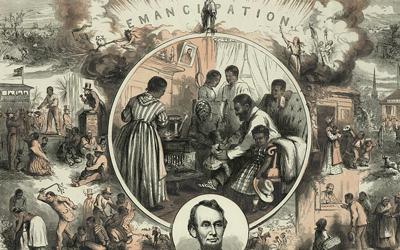
Description
In his 1865 image titled "Emancipation," Thomas Nast celebrates the emancipation of southern slaves with the end of the Civil War by contrasting a life of suffering and pain before the conflict with a life of optimism and freedom afterwards. The central scene shows the…
Certification of the 13th Amendment by Secretary of State William H. Seward, December 18, 1865
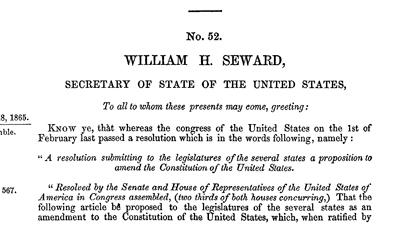
Description
On December 18, 1865, William H. Seward, the U.S. Secretary of State, officially certified the 13th Amendment after its approval by two-thirds of both chambers of Congress and ratification by three-fourths of the state legislatures.
“Slavery is Dead(?),” January 12, 1867

Description
Thomas Nast’s "Slavery is Dead(?)" appeared in the January 12, 1867, edition of Harper’s Weekly. Created five years after the Emancipation Proclamation, a year and two months after the ratification of the 13th Amendment and nine months after the passage of…
Hampton Plantation Account Book, 1868
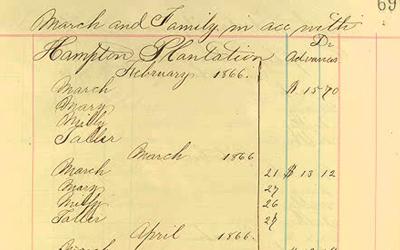
Description
After the Civil War, some slaves worked for their former owners as wage laborers. Page 69 of the Hampton Plantation (South Carolina) Account Book records monthly wages paid to March, Mary, Milly and Taller, a family of former slaves, for services rendered between…
"Family record. Before the War and Since the War," 1880

Description
Printed by the Krebs Lithographing Company in Cincinnati, Ohio, this 1880 family tree is designed specifically for former slaves. Titled, "Family Record. Before the War and Since the War," it includes a central image of a well-off, joyful African-American family.…
"Proportion of the Colored to the Aggregate Population: 1890," 1898

Description
Based upon the results of the 11th census, this map from the 1898 Statistical Atlas of the United States depicts the percentage of people of color per square mile across the United States. Although the heaviest concentrations are overwhelmingly in Maryland, Virginia…
“Startling Revelations from the Department of South Carolina,” 1864
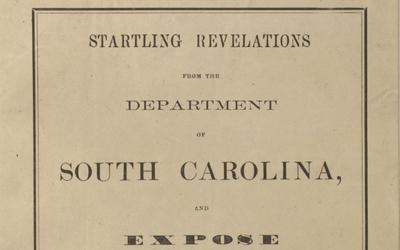
Description
The following excerpt was taken from an article that appeared in the Anglo-African magazine in 1864. In the article, Dr. Thomas P. Knox, who was hired as a doctor to treat freed slaves in South Carolina, recounts his firing and brief confinement in jail on…
"The Freedman's Bureau" Broadside, 1866
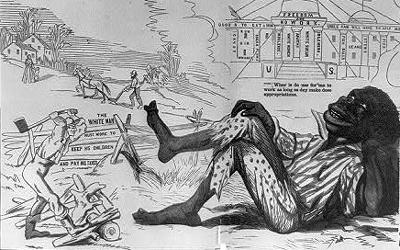
Description
Issued during the Pennsylvania gubernatorial election of 1866 on behalf of Hiester Clymer, who ran for governor on a white-supremacy platform, this racist poster supports President Andrew Johnson’s Reconstruction policies and is specifically critical of the Freedman’s…
Joint Resolution Proposing an Amendment to the Constitution of the United States, June 16, 1866
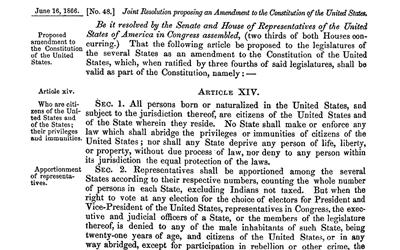
Description
On June 16, 1866, the U.S. Senate and House of Representatives proposed to the state legislatures what would become the 14th Amendment to the U.S. Constitution. After its ratification by the required three-fourths of the states, the amendment was officially certified…
Interview with Cane Cook, a Former African-American Sharecropper, with Reverend H.W. Pierson, 1870
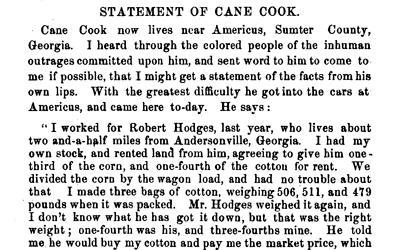
Description
In 1870, Reverend H.W. Pierson authored "A Letter to Hon. Charles Sumner, with 'Statements' of Outrages Upon Freedmen in Georgia, and an Account of my Expulsion from Andersonville, GA. by the Ku-Klux Klan." While serving as a pastor and teacher in Georgia, he…
"The Struggle between the Civilization of Slavery and that of Freedom" by Edward C. Billings, October 20, 1873

Description
On October 23, 1873, Edward C. Billings, a northern lawyer who moved to New Orleans in 1865, delivered an address in Hatfield, Massachusetts, to discuss the current state of Louisiana and the challenges faced by the recently-freed enslaved population.
“The Union as It Was,” 1874
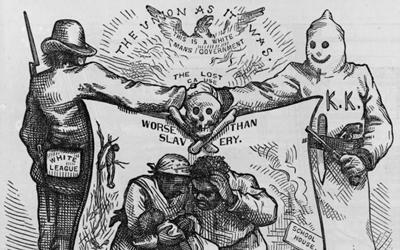
Description
In his 1874 cartoon titled, "The Union as It Was," Thomas Nast depicts a member of the Ku Klux Klan and a member of the White League shaking hands atop a skull and crossbones that rests above an African-American woman and man huddled over their dead child as a school…
"Shall We Call Home Our Troops? We Intend to Beat the Negro in the Battle of Life & Defeat Means One Thing — Extermination," 1875

Description
In this 1875 image published in the Birmingham (Alabama) News and titled, "Shall we call home our troops? We intend to beat the negro in the battle of life & defeat means one thing--EXTERMINATION," a group of five Southern white men is shouting at and…
"Black Laws" of 1861, 1864 and 1878, March 10, 1886

Download Resource Download Resource
Description
In the Ohio House of Representatives on March 10, 1886, B.W. Arnett of Greene County and J.A. Brown of Cuyahoga County delivered a speech in support of a bill calling for the repeal of the remainder of Ohio’s "black laws." Such laws began in Ohio in 1804, but most…
“Letter of Daniel R. Goodloe, to Hon. Charles Sumner, on the Situation of Affairs in North Carolina,” May 7, 1868

Description
In his May 7, 1868, letter to Massachusetts Senator Charles Sumner, Daniel R. Goodloe of North Carolina expressed his belief that on the whole, northerners were just as opposed to political and social equality for African Americans as southerners as evidenced by the…
George Smith's Statement on the Ku Klux Klan in an Interview with Reverend H.W. Pierson, 1870
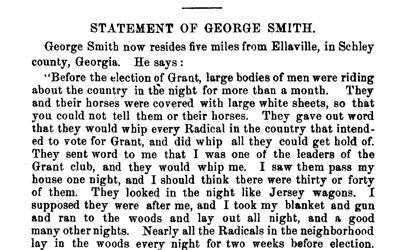
Description
In 1870, Reverend H.W. Pierson authored "A Letter to Hon. Charles Sumner, with 'Statements' of Outrages Upon Freedmen in Georgia, and an Account of my Expulsion from Andersonville, GA. by the Ku-Klux Klan." While serving as a pastor and teacher in Georgia, he collected…
Secretary of State Hamilton Fish’s Certification of the 15th Amendment's Ratification, March 30, 1870
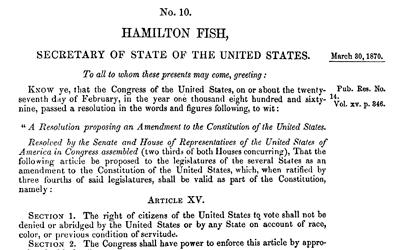
Description
On March 30, 1870, United States Secretary of State Hamilton Fish officially certified the 15th Amendment after its approval by two-thirds of both chambers of Congress and ratification by three-fourths of the state legislatures. The ratification of…
“The First Colored Senator and Representatives in the 41st and 42nd Congress of the United States,” 1872

Description
This 1872 portrait print published in New York by Currier and Ives depicts a group portrait of the first African-American legislators in the history of the United States Congress: Representative Robert C. De Large of South Carolina, Representative Jefferson H. Long of…
“Everything Points to a Democratic Victory This Fall,” October 31, 1874

Description
This October 31, 1874, image drawn by James Albert Wales for Harper’s Weekly depicts African Americans being discriminated against at the polls by the White League in their effort to vote for Republican Party candidates. A line of African-American voters…
“Radical Members of the First Legislature After the War, South Carolina,” 1876

Description
This 1876 photo montage depicts the first South Carolina legislature after the 1867 Reconstruction Acts. Names of each of the 65 members is listed below the photo montage. This legislature became the first in American history with an African-American majority.
Additional Resources
- "Time Line of African American History, 1852-1880"
This timeline provides a concise list of events from an African-American history perspective. - "Civil War and Reconstruction, 1861-1877"
This Library of Congress section of the American Memory Timeline includes a brief introduction/overview and primary sources for each of the following topics: The South During the Civil War, The North During the Civil War, African-American Soldiers During the Civil War, Civil War Soldiers’ Stories, The Freedmen, Reconstruction and Rights and The Travails of Reconstruction. - "Primary Documents in American History: 13th Amendment to the Constitution"
This Library of Congress web guide provides sources from a variety of collections within the Library of Congress, as well as external websites. - "Primary Documents in American History: 14th Amendment to the Constitution"
This Library of Congress web guide provides sources from a variety of collections within the Library of Congress, as well as external websites. - "Primary Documents in American History: 15th Amendment to the Constitution"
This Library of Congress web guide provides sources from a variety of collections within the Library of Congress, as well as external websites.
Iowa Core Social Studies Standards (9-12th Grade)
Listed below are the Iowa Core Social Studies content anchor standards that are best reflected in this source set. The content standards applied to this set are high school-age level and encompass the key disciplines that make up social studies for 9th through 12th grade students.
| No. | Standard Description |
| SS-US.9-12.13. | Analyze how diverse ideologies impacted political and social institutions during eras such as Reconstruction, the Progressive Era, and the Civil Rights movement. |
| SS-US.9-12.25. | Analyze how regional, racial, ethnic and gender perspectives influenced American history and culture. |
| SS-Gov.9-12.14. | Analyze the role of citizens in the U.S. political system, with attention to the definition of who is a citizen, expansion of that definition over time, and changes in participation over time. (21st century skills) |
| SS-Gov.9-12.19. | Evaluate the effectiveness of political action in changing government and policy, such as voting, debate, contacting officials, campaign contributions, protest, civil disobedience, and any alternative methods to participation. (21st century skills) |
| SS-Gov.9-12.24. | Analyze how people use and challenge public policies through formal and informal means with attention to important judicial processes and landmark court cases. (21st century skills) |